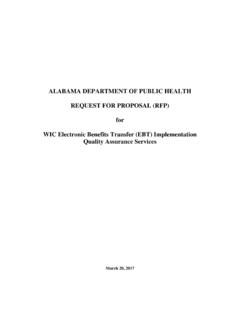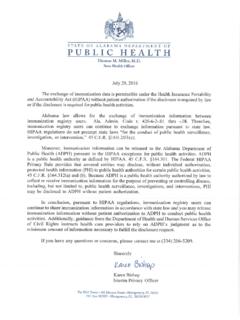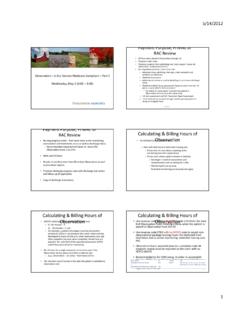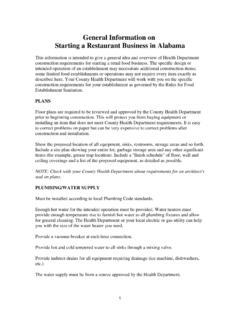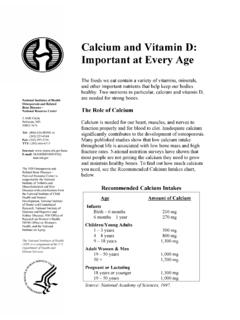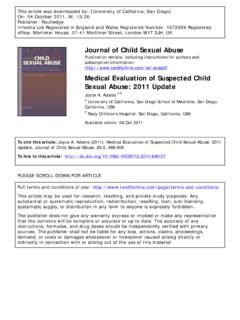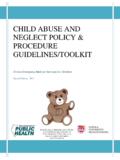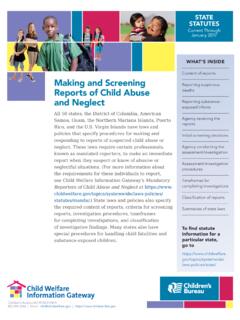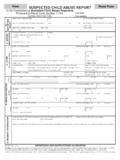Transcription of CONFIDENTIALITY OF CLIENT INFORMATION
1 CONFIDENTIALITY OF CLIENT INFORMATION The purpose of this section is to address the CONFIDENTIALITY of CLIENT health INFORMATION and disclosure of this INFORMATION relative to existing state and federal laws. Although the Health Insurance Portability and Accountability Act of 1996 (HIPAA) is a federal law established to improve privacy and security of confidential or protected health INFORMATION , it does not supersede state laws that are more restrictive. Please note that education records covered by the Family Educational Rights and Privacy Act (FERPA) are excluded from the definition of protected health INFORMATION under HIPAA. State agencies are now required by federal law to have policies and procedures in place to protect the privacy of health INFORMATION and to provide guidelines regarding accessibility and disclosure.
2 It is important that case managers adhere to the policies and procedures of their employing agency. INTRODUCTION Protecting the CONFIDENTIALITY of health INFORMATION has always been an integral part of the health care system. During the assessment process and subsequent case management activities, the case manager gains access to confidential INFORMATION relating to the CLIENT s personal, financial and medical conditions. Since the handling of confidential INFORMATION is routine for case managers, it is crucial that case managers protect and safeguard all confidential INFORMATION at all times in accordance with state and federal rules and regulations. The Health Insurance Portability and Accountability Act of 1996 is a federal law which establishes standards to improve privacy and security of individually identifiable health INFORMATION .
3 Under HIPAA, privacy is an individual s right to control access and disclosure of his or her protected health INFORMATION (PHI). Privacy defines who can access, use and disclose PHI. Security is an organization s responsibility to control the means by which such INFORMATION remains confidential. Security protects from unauthorized access and involves the storage and transmission of PHI. HIPAA sets forth a Privacy Rule and Security Standards to which covered entities such as health care providers and health plans (Medicaid, Medicare, etc) must comply. PRIVACY In general, the Privacy Rule: provides clients more control over their health INFORMATION provides guidelines regarding the accessibility, disclosure and use of health INFORMATION establishes appropriate safeguards that health care providers and others must achieve to protect the privacy of health INFORMATION Holds violators accountable, with civil and criminal penalties that can be imposed if they violate CLIENT privacy rights Each agency is required to publish and post its own privacy practices.
4 Case managers need to insure that clients are informed of these practices. If the CLIENT or CLIENT s representative believes the agency is not complying with its privacy practices or that his/her rights under HIPAA have been violated, the case manager should inform the CLIENT or CLIENT s representative of the agency s procedure for filing a complaint. Protected Health INFORMATION (PHI) Protected health INFORMATION exists when the individual s health/medical INFORMATION (including payment for healthcare) is combined with INFORMATION that identifies that individual. There are three major categories which include: personal INFORMATION such as name, date of birth, social security number, vehicle identifiers, license numbers; demographic INFORMATION such as address, telephone number, fax numbers, e-mail addresses, internet address number.
5 And, INFORMATION related to health status, services received or healthcare payment such as medical record number, diagnosis, dates of service, device serial numbers, health plan beneficiary numbers, account numbers, full face photographic images, and finger and voice prints Examples of PHI include Enrollment and Eligibility INFORMATION , Medical Reports and Records, Billing Records, Pharmacy Records, Prior Authorization INFORMATION , and any INFORMATION that contains an individual s identifier combined with any healthcare condition, service and/or payment. Education records covered by the Family Education Rights and Privacy Act (FERPA) including records designated as education records under Part B, C, and D of the IDEA Amendments 1997 are excluded from the definition of protected health INFORMATION .
6 The use and disclosure of PHI must be limited to the minimum necessary to accomplish the intended purpose. All uses and disclosures of PHI by case managers must be in accordance with state and federal HIPAA regulations. HIPAA regulations do not supersede state laws that are more restrictive in regards to safeguarding PHI. Individuals who can gain access to PHI without written authorization include: Employees directly involved in the evaluation and treatment of clients, or the processing of INFORMATION for payment and/or healthcare operations activities Health Department Officials (Such as reporting of INFORMATION on communicable diseases and/or vital statistics collection) Law Enforcement Officials (Such as reporting of suspected abuse, neglect or exploitation of children or adults, judicial proceedings and other law enforcement purposes)
7 Mandatory Reporting Code of Alabama 1975 26-14-1 provides for the mandatory and permissive reporting of child abuse/neglect to a duly constituted authority, primarily DHR and law enforcement, when any person suspects children are being abused or neglected, and 26-14-9 provides for immunity from any liability, civil or criminal, that might otherwise be incurred or imposed when any person makes a report in good faith. Persons and institutions mandated by 26-14-3 to report child abuse/neglect include all hospitals, clinics, sanitariums, doctors, physicians, surgeons, medical examiners, coroners, dentists, osteopaths, optometrists, chiropractors, podiatrists, nurses, school teachers and officials, peace officers, law enforcement officials, pharmacists, social workers, day care workers or employees, mental health professional or any other person called upon to render aid or medical assistance to any child when such child is known or suspected to be a victim of child abuse or neglect.
8 Alabama s Adult Protective Services Act deals specifically with abuse, neglect, and exploitation of adults who are incapable of protecting themselves. The law outlines the responsibilities of the Department of Human Resources, law enforcement authorities, physicians, caregivers, individuals, and agencies in reporting and investigating such cases, and in providing necessary services. The law generally identifies an adult in need of protective services as someone 18 years or older who is mentally or physically incapable of protecting himself from abuse, neglect, exploitation, or sexual or emotional abuse, and who has no one able and willing to assume proper care and supervision. Physicians, osteopaths, chiropractors, and caregivers are required by law to report instances of suspected abuse, neglect or exploitation, sexual abuse, or emotional abuse.
9 A caregiver is an individual who has the responsibility for the care of a protected person by virtue of family relationship, voluntary arrangement, contract, or friendship. Any concerned individual should make a report if he or she has reason to think that an adult is in danger of abuse, neglect, or exploitation. Those required to report must do so immediately on finding reasonable cause to believe that an adult has been subjected to abuse, neglect, or exploitation. Reports must be made either to the chief of police or sheriff, or the county Department of Human Resources. An oral report, either by telephone or in person, must be made first. It must be followed by a written report. Anyone reporting suspected abuse, neglect, or exploitation is presumed to be acting in good faith and is, by law, immune from legal action that might otherwise be incurred or imposed.
10 This immunity extends to all persons making reports and participating in judicial proceeding concerning those reports. Duty to Warn As a result of a number of court decisions, mental heath practitioners have become increasingly aware of and concerned about their double duty: to protect other people from potentially dangerous clients and to protect clients from themselves. These court decisions have mandated that practitioners have a responsibility to protect the public from potentially dangerous clients. This responsibility entails liability for civil damages when practitioners neglect this duty by failing to diagnose or predict dangerousness, failing to warn potential victims of violent behavior, failing to commit dangerous individuals, and prematurely discharging dangerous clients from the hospital.


